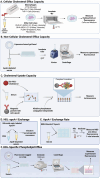Reverse cholesterol transport: current assay methods, alterations with disease and response to therapeutic intervention
- PMID: 40709204
- PMCID: PMC12286938
- DOI: 10.3389/fcvm.2025.1608384
Reverse cholesterol transport: current assay methods, alterations with disease and response to therapeutic intervention
Abstract
The removal of excess cholesterol from the body by High-density lipoprotein (HDL) in a process termed reverse cholesterol transport (RCT) has long been proposed to play a critical role in reduction of the lipid burden in arterial wall atherosclerotic lesions. While HDL-cholesterol levels are associated with decreased cardiovascular risk and considered to be "good-cholesterol", clinical studies using HDL-raising therapies to potentially enhance RCT have consistently produced disappointing results. In this mini review we evaluate the effects of human disease on RCT along with the changes in this process upon various therapeutic interventions. Despite the importance of assay standardization, the major method for monitoring RCT has relied upon the cholesterol efflux capacity (CEC) assay, a highly-difficult and tedious cell culture assay, which is low-throughput and only suitable for research studies. Hence, we also briefly review several new methods to measure RCT both in vitro and in vivo, along with new cell-free alternative RCT assays, which have the potential to be developed into routine automated diagnostic assay. The benefits of HDL may yet be revealed by the use of these new high-throughput RCT assays perhaps as a screening tool for novel RCT boosting agents or as new biomarkers for cardiovascular disease risk.
Keywords: ABCA1; ApoA-1; cholesterol; inflammation; reverse cholesterol transport (RCT).
© 2025 Playford, Neufeld, Zubirán and Remaley.
Conflict of interest statement
The authors declare that the research was conducted in the absence of any commercial or financial relationships that could be construed as a potential conflict of interest. The author(s) declared that they were an editorial board member of Frontiers, at the time of submission. This had no impact on the peer review process and the final decision.
Figures

Similar articles
-
Management of urinary stones by experts in stone disease (ESD 2025).Arch Ital Urol Androl. 2025 Jun 30;97(2):14085. doi: 10.4081/aiua.2025.14085. Epub 2025 Jun 30. Arch Ital Urol Androl. 2025. PMID: 40583613 Review.
-
Statins for Smith-Lemli-Opitz syndrome.Cochrane Database Syst Rev. 2022 Nov 14;11(11):CD013521. doi: 10.1002/14651858.CD013521.pub2. Cochrane Database Syst Rev. 2022. PMID: 36373961 Free PMC article.
-
The Black Book of Psychotropic Dosing and Monitoring.Psychopharmacol Bull. 2024 Jul 8;54(3):8-59. Psychopharmacol Bull. 2024. PMID: 38993656 Free PMC article. Review.
-
Systemic Inflammatory Response Syndrome.2025 Jun 20. In: StatPearls [Internet]. Treasure Island (FL): StatPearls Publishing; 2025 Jan–. 2025 Jun 20. In: StatPearls [Internet]. Treasure Island (FL): StatPearls Publishing; 2025 Jan–. PMID: 31613449 Free Books & Documents.
-
Short-Term Memory Impairment.2024 Jun 8. In: StatPearls [Internet]. Treasure Island (FL): StatPearls Publishing; 2025 Jan–. 2024 Jun 8. In: StatPearls [Internet]. Treasure Island (FL): StatPearls Publishing; 2025 Jan–. PMID: 31424720 Free Books & Documents.
References
Publication types
LinkOut - more resources
Full Text Sources

